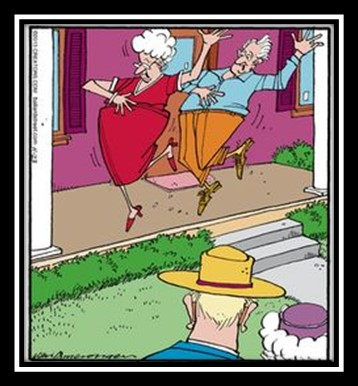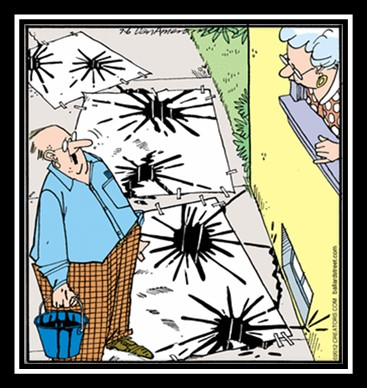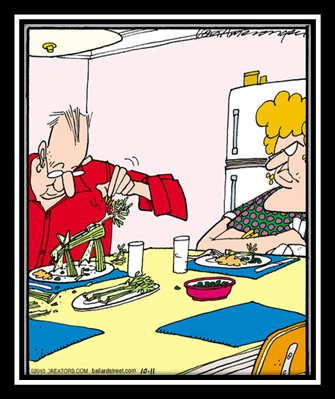Why the Arts Matter Most in the Darkest Times
Good Friday, afternoon everyone:
I slipped into a long conversation with a friend yesterday about the importance of the arts when the times seem most dark. It recalled for me a note I wrote at the height of COVID, echoing that theme. When I re-read it, I was struck by how much darkness is darkness, regardless of whether precipitated by a pandemic or an insidious policy environment, I thought I might resend it.
Rip
September 9, 2020
Good evening, everyone:
So much of the balm we’ve needed during this cataclysmic time has come from the arts – through endless varieties of watching, consuming, participating, making:

The Fergusons get their exercise during COVID from
synchronized porch dancing

Creativity is Messy, Irene

Looking for new creative outlets, Graham builds
a fox out of his celery
(with thanks to my favorite cartoonist: Jerry Van Amerongen)
I was asked last week to talk about the arts to one of the nation’s leading institutes on design and creativity – the Herberger Institute for Design and the Arts at Arizona State University – to discuss how Kresge sees arts and culture’s role in helping us navigate through the interlocking health, economic, and racial reckoning pandemics. I thought I might share the remarks I used to frame that conversation:
The inter-braiding impacts of the pandemic, economic recession, and the racial justice movement are leading to converging priorities anchored in racial and social justice. Art and creativity are compelling platforms to convey the ire and action required to imagine a racially-just society, while re-weaving the fabric of social and emotional connection so integral to building, sustaining, and enhancing community life.
It’s not just the endless varieties of work product – whether poetry or painting . . . musical performance or theatrical production . . . dance or design – that help us cope and imagine. It’s also the process of creativity in all its dimensions – collaborations with others working beyond one’s own art form . . . engagements across generations and geographies to foster and fortify a sense of shared identity, purpose, or direction . . . activities rooted in community life that re-set expectations about the endless ways that arts and culture can illuminate new pathways to healthier and more just and equitable community. The arts have simultaneously moved us as a society to a point of inward reflection and furnished us with instrumentalities to spread our imagination and creativity outward.
It is a time of unprecedented importance for community-immersed work. We need look no further than the role we have seen artists play in the places Kresge works – Detroit, Memphis, New Orleans, Fresno, Kansas City, Milwaukee, Minneapolis, and others. Since COVID . . . since George Floyd and Breanna Taylor and Jacob Blake . . . since the shredding of the economic safety net . . . it has become crystal clear that arts and culture hold a privileged position of responsibility and agency in these places. In helping civil society adjust to the public health crisis. In holding out hope for a better economic future. In advancing the accelerating energies of racial reckoning and healing, reconciliation and justice.
This “superpower” is grounded in the fundamental belief on the part of community residents that the creative process is indispensable to vibrant, healthy, hopeful communities. Whether assuming the form the jazz performance at the local coffee shop or the mural created on the street by Black Lives Matter activists . . . the mosaic created by school children in a newly landscaped park or the theatrical production that draws residents into a conversation about public safety. It is a power that flows from myriad wellsprings:
· From the arts’ ability to endlessly shape-shift in intention . . . tone . . . and form.
· From the direct connection between the artist’s creative spark and deeper reflections on the human condition – helping us to see the problematic and explore the promising . . . to unsettle the insular and the dormant and unearth the unexpected and the fresh . . . to accept the reality of the repellant and offer up the possibilities of the beautiful . . . to confront assumptions of what is good and what is bad, what is false and what is true.
· From the ability of culture workers to tie a creativity born of the moment back to the rich and painful legacies of the past and forward to collective aspirations for the future.
· From the courage of the arts to detect order within disorder and to give us tools to help process anxiety and grief.
· From the clarity of the arts’ embrace of connection and inclusion as an antidote to isolation.
· From the potency of the arts to serve as a vehicle of social articulation to those who – after years of being thwarted by politics, bureaucracy, and legal processes – are tired of waiting.
We navigate through these days of dreadful uncertainty, and tragedy, and pain by calling on the arts to help us stand outside ourselves, question the way we see the world, and imagine solutions beyond the default settings we have inherited.
Specifically, at Kresge we have kept the importance of the arts front and center in our work to help cities stabilize, re-imagine, and recover. We believe that there has not been a time when creative placemaking has been more important. A long, enduring investment in the arts, and in individual artists, is an insurance policy – that we never lose sight of our common humanity, never overlook the travails of our history, and never give up hope for the boundless possibilities for our future.
Regina sent along the following poem entitled “A Journey,” by Nikki Giovanni – something to take with us as we move into what will unquestionably be a complicated and challenging Fall:
It’s a journey . . . that I propose . . . I am not the guide . . . nor technical assistant . . . I will be your fellow passenger . . .
Though the rail has been ridden . . . winter clouds cover . . . autumn’s exuberant quilt . . . we must provide our own guide-posts . . .
I have heard . . . from previous visitors . . . the road washes out sometimes . . . and passengers are compelled . . . to continue groping . . . or turn back . . . I am not afraid . . .
I am not afraid . . . of rough spots . . . or lonely times . . . I don’t fear . . . the success of this endeavor . . . I am Ra . . . in a space . . . not to be discovered . . . but invented . . .
I promise you nothing . . . I accept your promise . . . of the same we are simply riding . . . a wave . . . that may carry . . . or crash . . .
It’s a journey . . . and I want . . . to go . . .
Rip